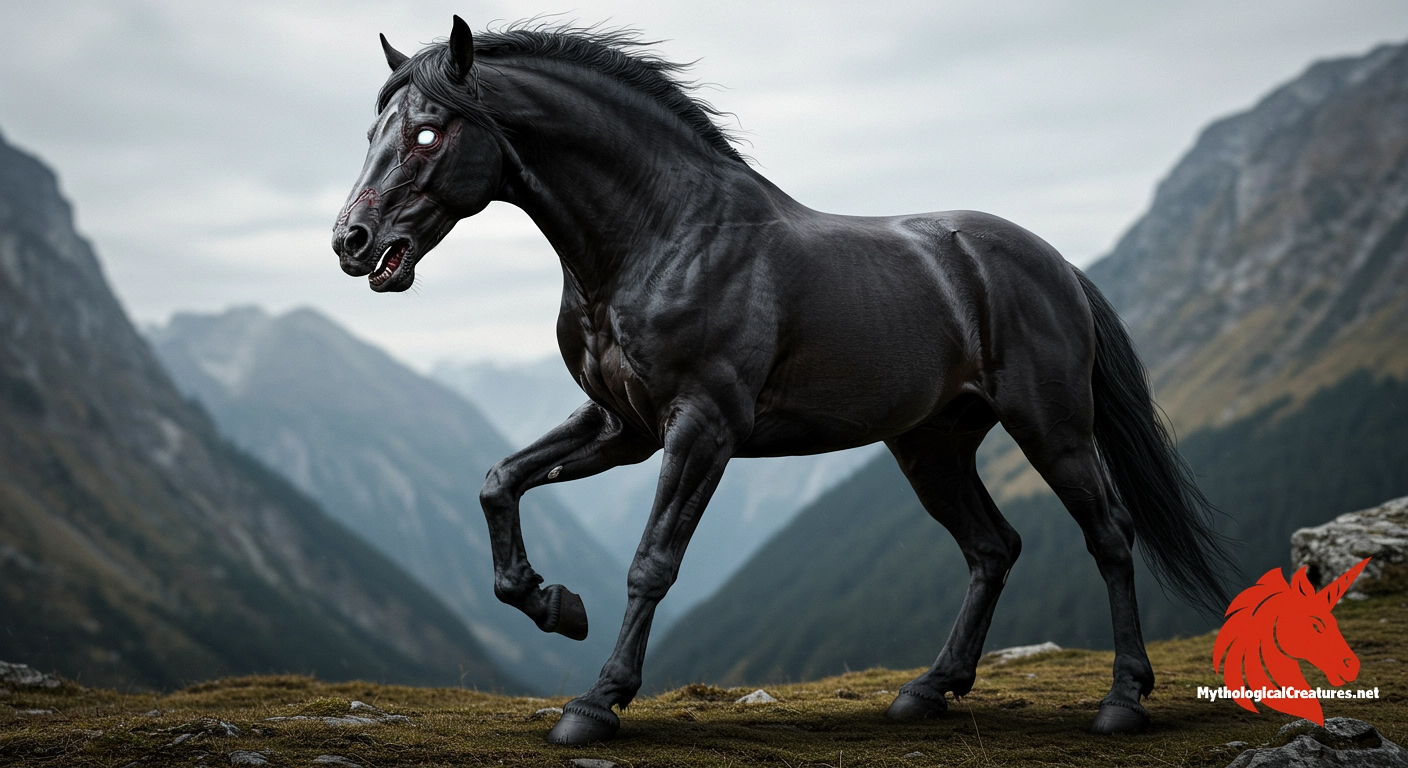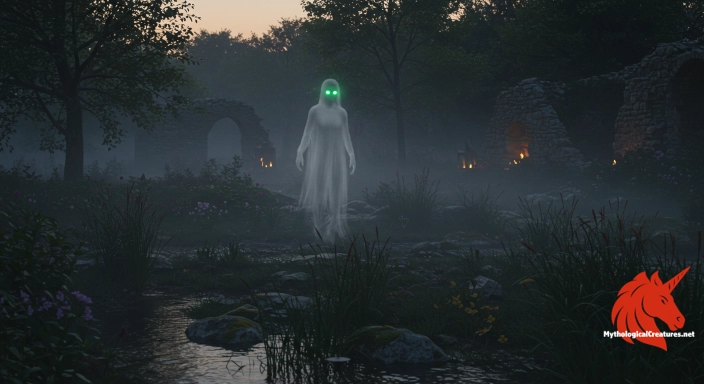Cheval Gauvin: Cheval Gauvin is a legendary evil horse from the folklore of Franche-Comté, France and the Jura Mountains in Switzerland.

Cheval Gauvin
Cheval Gauvin - Serves as a cautionary figure symbolising impending doom and is used as a bogeyman to frighten children.
Origins & First Encounters
The Cheval Gauvin stands as one of the more sinister apparitions in the folklore of the Franche-Comté and Jura regions, renowned for its malevolent nature and eerie wanderings. It emerged from the shadowy tapestry of local myth, first notably recorded in mid-19th century France. The beast’s origins are shrouded in mystery, often hinted to be the result of a goblin’s transformative curse that imbued it with a dark will. Its reputation as a creature that roams watercourses, dense forests, and somber graveyards paints an image of a being at home in the liminal spaces between life and death. Local narratives speak of its relentless pursuit of riders, meting out fate by drowning or hurling them into fathomless abysses. The creature has evolved into a spectral emblem of the unpredictable and perilous forces of nature. Over centuries, its legend has served as both a cautionary tale and a mythic explanation for sudden, unexplained tragedies. The Cheval Gauvin not only captures the dark imagination of local inhabitants but also reflects the cultural intersection between the natural and supernatural worlds.
Source Texts & Tale Variants
The earliest collective account of the Cheval Gauvin was recorded in Chamblay by Désiré Monnier in 1854, marking the creature’s initial documented appearance. Multiple variants of its story have been preserved across various regions, including Montbarrey, Joux, and Dole, highlighting the widespread nature of its legend. Local oral histories often blend a mixture of fear and fascination, recounting encounters that vary in detail yet share a consistent theme of malevolence. In the Swiss cantons, especially among the residents of the Jura and Bernese Jura, the accounts introduce elements such as the abduction of young girls and spectral galloping through village streets. The narrative in France tends to emphasise its association with water, forests, and the cursed graveyard pathways it frequents. A particularly striking variant links the horse to the medieval lord Amauri III de Joux, adding a historical layer to its mythos. A woman’s chilling encounter in the Chamblay cemetery has been passed down as a stark reminder of the creature’s uncanny presence. Various texts and folklore compilations have since contributed to the multiplicity of its portrayals, ensuring that the Cheval Gauvin continues to captivate and alarm storytellers and listeners alike.
Form & Powers
The physical depiction of the Cheval Gauvin varies widely across the collected legends, yet a spectral, almost otherworldly quality remains a constant feature. Some accounts describe it as a massive, imposing steed with a dark, glossy coat that seems to shift between deep blacks and eerie greys under the faintest light. Its eyes are often said to glow with a dim, malevolent light, evoking the chill of a winter night. The mane and tail are depicted as wild and unkempt, as if perpetually caught in an unseen wind, lending the creature an air of feral abandon. In many narratives, its hooves strike the ground with an ominous reverberation, as though marking the drumbeat of impending doom. The creature's form is sometimes described as blurred at the edges, suggesting an ethereal quality that allows it to both materialise and vanish in a blink. Variations in size are noted, with some tales portraying the beast as an oversized predator and others as a deceptively sleek, agile entity. Such shifting descriptions contribute to the aura of unpredictability and terror that surrounds the Cheval Gauvin.
Regional Faces
Regional adaptations of the Cheval Gauvin reveal intriguing subtleties in its character and the fears it embodies. In the heartlands of Franche-Comté, the legend focuses on the creature’s diabolical intent to overwhelm and destroy those who dare mount its back, emphasising its lethal association with water and dark landscapes. Conversely, within the Swiss Jura, local lore imbues the horse with an almost supernatural role in village life, where it is said to roam freely and even abduct unsuspecting young girls. The distinctly different environmental backdrops—French graveyards and watery ditches versus Swiss village lanes—underscore a flexibility in its depiction that adapts to local cultural anxieties. In both areas, however, the creature is universally recognised as a portent of death and misfortune. Rural communities have woven the Cheval Gauvin into their collective memory as both a warning and curious enigma. Local festivals and oral traditions sometimes recount the horse’s advance as a spectral omen, reinforcing its status as a living symbol of regional mysteries. These regional variations ensure that while its core malevolence remains constant, its narrative contours are reshaped by the cultural customs and geographical settings of its storytellers.
Cultural Parallels
Across various European mythologies, the Cheval Gauvin shares similarities with other legendary equine figures that occupy the borders between the natural and supernatural. It finds a parallel in the Celtic kelpie, a water spirit that lures riders to a watery grave with enchanting yet deadly allure. Like the headless horseman in later European tales, the Gauvin horse epitomises the terrifying unpredictability of an unearthly steed. Comparative analysis suggests that both creatures serve as metaphors for the inadvertent flirtation with death and fate’s inexorable approach. In northern European folklore, the spectral mounts of the Wild Hunt evoke a similar dread and fascination, linking the inevitability of death to otherworldly riders. The recurring motif of a cursed or transformed goblin also finds echoes in various regional stories, where transformations lead to monstrous incarnations. These cultural parallels highlight a shared narrative tradition that uses the image of a relentless, ghostly horse to represent mortality. Such cross-cultural connections invite deeper reflection on how societies employ animal symbolism to grasp the mysteries of life and mortality.
Legacy & Modern Evolution
The Cheval Gauvin has evolved significantly over time, transitioning from a mere cautionary tale to a robust symbol entrenched in both historical lore and modern interpretations of folklore. While early accounts emphasised its role as a harbinger of death meant to scare children, later retellings have endowed it with layers of ambiguity that provoke both fear and empathy. The creature’s depiction has softened in some modern literary works, where it is sometimes reimagined as a misunderstood spirit caught between realms. Contemporary artists and writers often use the Cheval Gauvin as a metaphor for the elusive nature of fate and the perils that lie hidden in the beautifully dangerous world of nature. Its image continues to inspire local festivals, art installations, and theatrical productions that celebrate the dark undercurrents of regional myths. Scholars and folklore enthusiasts regard the legend as a compelling example of how stories adapt over time to reflect shifting cultural landscapes. The enduring appeal of the Cheval Gauvin lies not only in its chilling narrative but also in its capacity to mirror the evolving human relationship with the supernatural. Today, it remains an emblematic figure in the folklore of the Jura and Franche-Comté, captivating new audiences with its enigmatic lore and timeless mystique.
Interesting Fact
An intriguing aspect of Cheval Gauvin's legend is its dual identity as both a spectral harbinger of death and possibly a cursed creature born from a goblin's transformation, reflecting the complex interplay of fear and folklore.
Quick Creature Info
Features:
Our Mythic Legendary Rating:

Also Sometimes Known As:
Habitat:
Supernatural Powers:
Physical Attributes:
Abilities:
Behavior:
Lore:
Related Creatures, Tales or Lore
References
Discover Another Mythical Legend You May Not Have Heard Of?
Uncover the mysteries of ancient folklore and expand your knowledge of legendary beings from cultures around the world.
Dare to Meet the Xhindi....
Curated by the Mythological Creatures Team (rev. May 2025)
